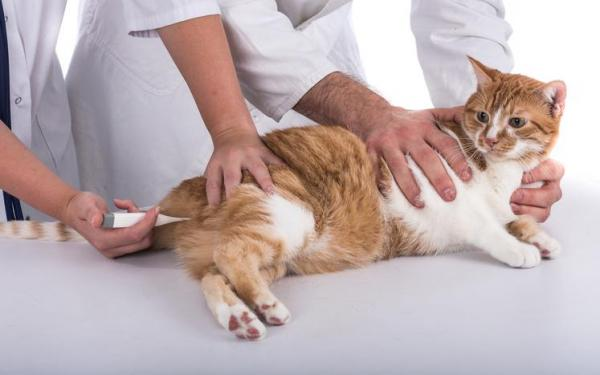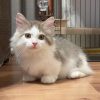
Cats can suffer adverse effects from being exposed to extreme temperatures. They have the ability to thermo-regulate, but sometimes the temperatures can be too harsh for them. So what is the best temperature for indoor cats to thrive in?
Did you actually know that your cat has the ability to ensure that it does not suffer from extreme temperatures? However, it is not so elaborate, and sometimes the temperatures can get too high or too low for them. In cold environments, cats use their thick undercoats to keep warm. The fur is thicker near the skin so it keeps cold from penetrating.
Cats have a normal body temperature of between 100 and 102 degrees Fahrenheit. Seeing that it is higher than that of humans, it indicates that they can be able to handle higher temperatures than we can. Your cat is more likely to be comfortable in a hot summer than you are. However, they do not have the capacity to sweat as much as we do, and sweating for them is only restricted to the paw pads, nose and the tongue, but only in special circumstances. Extreme heat can cause your cat to suffer heat stroke which can be fatal.
For the optimal comfort of your cat as regards the ideal temperature for them, try and maintain a temperature range of 65 to 75 degrees Fahrenheit. This may seem like a wide range, but most cats of different species and ages are comfortable within this range.
So what is it that influences the ideal temperature level of your cat? Let’s have a look.
Factors that influence a cat’s temperature adaptability
Breed
This is by far the most important factor for your cat. Different breeds have varying coat thickness. A cat breed with thick fur, like a Maine Coon or Persian, is more likely to get uncomfortable in high temperatures than a Bengal cat which has a short fur coat. The long fur acts as a trap for hot air and gives the felines a slightly lower tolerance to heat.
The inverse also applies in the cold. The long fur coat breeds have a higher tolerance to cold than short fur coat cats. Breeds such as the Sphynx which are entirely furless need a lot more heat during the cold than other cats with fur.
Size
This has largely to do with the surface area to volume ratio. A bigger cat has the ability to retain more heat than a smaller cat. You may have to ensure that your smaller felines are well catered to during the colder seasons as they are prone to experiencing cold related complications.
Age
A kitten may not have defined physiological functions as an adult cat. An older feline is able to generate a lot more heat and can, therefore, withstand lower temperatures.
Health
Healthy felines have the ability to withstand extreme temperatures, both high and low. A sick cat’s body may not be able to supply enough body heat during low temperature seasons. You may want to keep it warmer when it is unwell.
So how can you tell that your cat is too hot?
It is possible to know whether your cat is feeling too hot, but you may have to keep a keen eye. Your cat will exhibit the following characteristics;
- Red gums
A feline’s gums normally have a pale color. If you notice that they are red, it is an indication that your cat is too hot.
- Reduced activity
A cat that is experiencing the effects of excess heat becomes sluggish and its activity reduces drastically. You may also notice that your cat’s gait becomes wobbly and less coordinated.
- Panting
It is not normal for a cat to pant as a cooling mechanism. This is more commonly observed in dogs. If you notice that your cat is panting, it may be an indication that your cat is overheating.
- Vomiting and diarrhea
Cats may vomit and diarrhea when they are experiencing extreme heat. This may cause your cat to be dehydrated.
And what signs indicate that your cat is too cold?
Here are some of the signs that show your cat is feeling extreme cold;
- Positioning
When your cat is feeling too cold, you will notice that it hides its paws beneath its body. It also tends to curl up in a tight ball in an effort to preserve body heat.
- Seeking warmer environments
You may notice our cat seeking warm environments in which to rest, especially sunny surfaces. Your feline may also try to press their bodies against yours a lot more than usual in an attempt to get warmer.
- Cold ears and tail
When a cat is cold, the ears and tail become cold to the touch. This is mostly because they receive lower blood supply than the rest of the body. While they are normally cooler than other body parts, they become much colder when they are feeling a lot of cold.
How to maintain conducive temperatures for your cat
Here is how to ensure that your cat is comfortable as far as temperatures go.
- If you have an AC, ensure it stays on during hot summers. If you do not have one, use fans and ensure the house is well ventilated.
- Ensure that your cat stays hydrated in hot temperatures. Have a bowl of clean water for it at all times.
- Ensure that your cat does not spend too much time outside during wintery months.
- Provide more bedding and move the cat bed to a warmer environment.
Final Verdict
A feline’s well being is one of the most important aspects to its keepers. While a lot of focus goes into their feeding and other health aspects, very little thought goes into how warm or hot they are. It is important to ensure that your cat is well catered for to eliminate the risk of heat stroke and hypothermia, especially during extreme temperatures.


